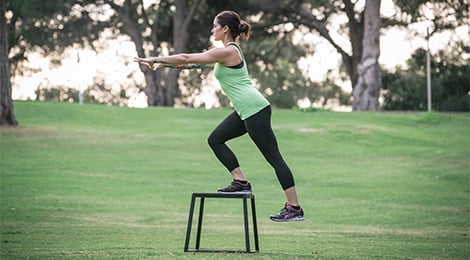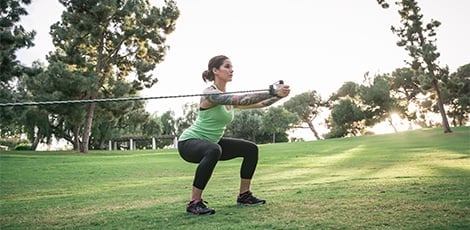There are several things you can do to make your trip up a 14er (a mountain that meets or exceeds 14,000 feet) both successful and enjoyable. Being hydrated and fueled, pacing yourself correctly, and having proper training and equipment are essential. When preparing to tackle a 14er, the most essential training aspects to focus on are cardiovascular endurance, strength and stability, and flexibility.
Eighty-nine peaks in the United States meet or exceed 14,000 feet. Many are technical, requiring glacier travel or vertical climbing skills. This article focuses on training for the non-technical 14ers, which test your mettle against a long day (or two) of hiking at altitude.
Keep in mind that even non-technical 14ers may involve snow travel depending on the time of year, so be sure you're familiar with the equipment and techniques you'll require as well as the route and conditions of your chosen peak.
As always, be sure to consult with your doctor before starting any new training routine.
Training Schedule for Climbing 14ers
In preparing to tackle a 14er, aim to work out at least five days per week, with at least one day of active rest that includes light walking or a stretching/foam-rolling session. Three of the days focus on interval training and full-body strength workouts, two days will include longer steady-state cardiac-output workouts, and one day can be designated as a training hike day or bonus steady-state cardio day.
Sample week
| Monday | Tuesday | Wednesday | Thursday | Friday | Saturday | Sunday | |
| Cardio | Intervals, 30-45 minutes | Steady-state Cardio, 45-90 minutes | Intervals, 30-45 minutes | Steady-state Cardio, 45-90 minutes | Intervals, 30-45 minutes | Bonus Steady-state Cardio, 45-90 minutes; OR hike with a vertical gain and pack | Active Recovery |
| Strength | Full body, 3 sets of each exercise | None | Full body, 3 sets of each exercise | None | Full body, 3 sets of each exercise | None | None |
| Flexibility | Stretches for major muscle groups | Stretches for major muscle groups | Stretches for major muscle groups | Stretches for major muscle groups | Stretches for major muscle groups | Stretches for major muscle groups | Stretches for major muscle groups |
Cardio Training for Climbing 14ers
The cardiovascular training component of this program focuses on maximizing your ability to use oxygen. That's because as you gain elevation, atmospheric pressure decreases, which means you aren't able to get the same amount of oxygen into your lungs as you would at lower elevations. People can start feeling the effects of altitude at elevations as low as 5,000 feet.
Steady-State Cardio Training
Moderate-intensity steady-state cardio improves your cardiac output by increasing the volume of blood your heart pumps with each beat. Your cardiac-output days should include 45 to 90 minutes of low- to moderate-intensity cardio activity such as swimming, biking, jogging or rowing. You should work at a comfortable pace, but hard enough to make you break a sweat.
Throughout your training, be sure to include some training hikes to elevation, as well:
Hike Progressions
| Distance | Pack Weight | Elevation Gain | |
| Training Hike #1 | 6-8 miles | 20-30 pounds | 1,500-2,500 feet |
| Training Hike #2 | 6-8 miles | 20-30 pounds | 2,000-3,000 feet |
| Training Hike #3 | 7-9 miles | 20-40 pounds | 2,000-3,000 feet |
| Training Hike #4 | 7-9 miles | 20-40 pounds | 3,000-4,000 feet |
| Training Hike #5 | 8-10 miles | 20-40 pounds | 3,500-5,000 feet |
| Training Hike #6 | 6-8 miles | 40+ pounds | 3,500-5,000 feet |
| Training Hike #7 | 7-9 miles | 30-40 pounds | 3,000-4,000 feet |
High-Intensity Interval Training
High-intensity interval training will improve your VO2max, which is the maximal amount of oxygen your body is able to absorb, transport and, ultimately, use during exercise.
For optimal interval training, it's important to understand and calculate your heart-rate training zones, ideally using a heart rate monitor. For information about how to choose and use heart rate monitors, see our Expert Advice Articles, Fitness Electronics: How to Choose and Heart Rate Monitors: How to Use.
Your interval days will challenge you both physically and mentally. You'll be fighting the desire to quit on the high-intensity intervals. After a thorough warm-up, push your intensity to about 85 to 90 percent or your max heart rate (HR), or a 9 on a scale of 1 to 10.
Once you reach your target HR, maintain it for two minutes. The clock starts when you reach that heart rate (not when you start the effort). Over the course of your training program, eventually work your way up to maintaining it for four to five minutes.
Interval training is all about the ratio of rest to work, so be sure to keep a period of active rest after each high-intensity burst. If you work hard for one minute at the beginning of your training program, two-to-three minutes of active rest should follow to allow for recovery before the next interval.
As you progress in your training, increase the amount of work time and decrease the amount of active rest. A 15-minute interval training session that consists of a 1:3 ratio (one minute of work followed by three minutes of active rest) is a great place to start. Nearing the end of your program, you may work toward 30 total minutes of intervals with a ratio of 4:1 (four minutes of work followed by one minute of active rest).
Strength Workout for Climbing 14ers
The following training program includes a series of full-body strength and stability exercises to help your legs climb for hours at a time. Plus, a strong core can help keep you stable, and with the use of hiking poles, a powerful upper body can help drive you uphill or transfer some of the impact when descending the mountain.
Repeater Step-Ups With Overhead Press


- Stand in front of an 18-inch bench, step or plyobox while holding two dumbbells at shoulder height.
- Place one foot solidly up on the bench and step up and through with the back foot as if stepping on to another step while driving the weights straight up overhead; straighten the fixed leg. Return the weights and back leg down together to the starting position.
- Repeat at a quick but controlled pace for 12 to 15 reps.
- Rest briefly (less than 30 seconds) and then do the same movement while leading with the opposite leg up.
Exaggerated Step-downs

This exercise helps prepare the body for the impact that comes with descending the mountain.
- Stand on a 12- to 18-inch step.
- Step off with an exaggerated step, landing on the ground and absorbing the impact to make the landing as soft as you can.
- Carefully bring the other foot down, get back on step and repeat 10 to 20 times per leg.
Anti-Rotation Squats

- Attach the center of a resistance band to a solid anchor point. Face away from the anchor point and route both sides of the band to one side of your body. Hold both handles with both hands directly in front of your belly button, with a slight bend in your elbows and the band stretched.
- Keep your hands at the same point and don't let the band rotate your torso as you press your hips down and back into a squat. Stop when your thighs are approximately parallel with the ground.
- Drive your hips and torso back up to the upright position again, still fighting to keep the band from rotating your torso.
- Perform 15 to 20 reps with the band pulling from either the left or the right and then switch sides.
Split Squat With Band Row


- Wrap a resistance band around a solid anchor point and hold one handle in each hand while facing the anchor point.
- Stand in a split stance with one foot forward and one foot back. When you lower your body, your forward leg will be just slightly angled forward (without having the knee go past the toes) and the back knee will be bent approximately 90 degrees, with the knee hovering 2 to 3 inches above the ground. Perform a split squat, pulling your elbows just past your ribs as you come up; be sure to keep the torso in a tall, upright position.
- Complete 10 to 15 reps with each leg forward.
Single-Leg Romanian Dead Lifts


- Begin by holding a dumbell in the opposite hand to the planted foot.
- Keep a neutral spine and only a slight bend in the planted leg as you hinge forward while lifting your other leg and keeping it straight from the hip.
- Once you have achieved your end range of motion (your body should form a capital T if you have the mobility), lower that leg back to the ground.
- Perform 10 to 15 reps on each leg.
Modification: If you are struggling with perfect form, remove the weight and first master the hip hinge.
Push-ups


- Lie face down on the floor with your with hands positioned at mid chest, a few inches away from your sides.
- Place your toes on the ground and brace your core tightly as if you're going to get punched in the gut.
- Press your whole body up in one smooth motion. If this is too challenging, place the knees on the floor and aim to lift your hips and torso together.
Stretching for Flexibility
After completing your cardio and strength training sessions, take some time to thoroughly stretch the whole body. If time is short, perform at least one static stretch for each of these major areas: hamstrings, quadriceps, hips and calves. Hold each stretch for 30 seconds to receive the most benefit, and don't forget to breathe while stretching. This commitment to recovery will help prepare your body for your next workout.
The nonprofit American Council on Exercise (ACE) educates, certifies and represents more than 53,000 fitness professionals, health coaches and other allied health professionals.
This publication is not intended to provide medical advice on personal health issues, which should be obtained directly from a physician.
